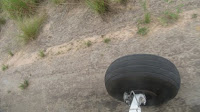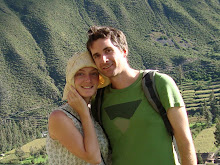We’re just back from an incredible 5 days in the Colombian jungle, in the


We were relieved to arrive in the village – which seemed very isolated when we arrived, but after 5 days walking and encountering communities all over the jungle, on the way back, it seemed pretty connected. The trek was beautiful, exhilarating, fascinating and at times terrifying. We climbed up through mountains, surrounded by jungle which opened out into terrific panoramic views. It rained every day, but in the first couple, it absolutely poured it down from late morning. We waded across countless rivers – on our first river crossing we removed our shoes and socks and got the towel out on the other side (Simon didn’t go as far as talc). 



We had a lovely guide who had grown up in the mountains. We slept in hammocks around his family home on our first and last nights.
 The nearest village to his home was a good 3 hour trek which he used to make there and back every day and then work in the fields in the afternoon. Coca farming had been widespread in the region but is now less so due to several US backed ‘initiatives’ to eradicate it in the ‘80s and ‘90s – aerial drops of chemicals devastated the jungle and poisoned many of the people living in the area. As a result, apparently they still can’t grow avocadoes. This area, in the lower
The nearest village to his home was a good 3 hour trek which he used to make there and back every day and then work in the fields in the afternoon. Coca farming had been widespread in the region but is now less so due to several US backed ‘initiatives’ to eradicate it in the ‘80s and ‘90s – aerial drops of chemicals devastated the jungle and poisoned many of the people living in the area. As a result, apparently they still can’t grow avocadoes. This area, in the lower
Just a bit further into the mountains the guerrillas rule, it is a no-go area for most locals and definitely tourists and most of the cocaine in the region is produced here. A cocaine tourist attraction in the area is tolerated by the military. We declined to pay and go but others in our group did. In a small factory set up, tourists are shown how coca leaves are converted into a cocaine base (they stop before turning it into powder) using chemicals – petrol, sulphuric acid and all sorts. Most farmers grow maize, yuca, bananas, pineapples, potatoes, coffee and cocoa. They rarely sell their products to market because they are so far away and the prices they receive don’t make it worth it. A lot of the farming is subsistence. Now there is more peace in the region since the guerrillas and coca production decreased, it seems like quite an amazing place to live in many ways. Generations of families live together or nearby, and they can drink clean water from the streams and rivers and bathe by waterfalls.
We returned filthy but happy in a dilapidated 4x4, with windows held in by string, sat sideways bumping down the mountain with a live rooster under Simon’s legs – a present for the driver’s friend’s birthday – in torrential rain which poured in through the gaps in the vehicle’s bodywork and down our backs. Our guide just laughed and asked if we wanted soap passing back. A sense of humour for the ridiculous seems to be a must here and if you have it, it’s a lot of fun.

















































